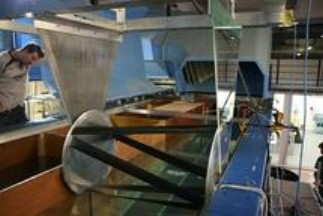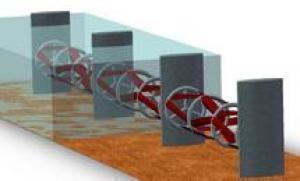Nov
1
A New Tidal Flow Generator
November 1, 2010 | 11 Comments
Oxford researchers have developed a new tidal turbine that has the potential to harness tidal energy more efficiently and cheaply. Now the technology has been licensed to new company, Kepler Energy Limited, formed to develop the tidal turbine and to build the device simply, more robust and more scaleable than current commercial designs.
The turbine is the result of research in Oxford University’s Department of Engineering Science by Professor Guy Houlsby, Professor of Civil Engineering, Dr Malcolm McCulloch, head of the electrical power group, and Professor Martin Oldfield, Emeritus Professor of the thermofluids laboratory.
The key in tidal is robust. Tidal energy with the mass of water involved is much more forceful than the air harnessed by wind energy technologies.

Oxford University Tidal Turbine Prototype. Image Credit: Oxford University. This is the largest image.
A prototype 0.5 meter diameter turbine has already performed well in tests, proving the benefits of the blade design. The design as built and tested is a horizontal axis water turbine, to intersect the largest possible area of current. The rotor is cylindrical and rolls around its axis, catching the current. A full-scale device would measure up to 10 meters in diameter, and a series of turbines can be chained together across a tidal channel.
The team has calculates that a tidal site 1-kilometer in width could produce 60 Megawatts of energy.
The real beef is in the engineering – the turbine is mechanically far less complicated than anything available today, and requires fewer generators and undersea foundations, meaning it will cost less to build and maintain. The manufacturing costs are estimated to be about 60% lower and the maintenance costs 40% lower than current tidal devices.
The researchers received £50,000 in funding from the Oxford University Challenge Seed fund, managed by Isis Innovation, to build a 0.5-meter diameter prototype demonstrating the benefits of the design. Tom Hockaday, managing director at Isis Innovation said: “This is the latest in a number of spin-outs from the Department of Engineering Science. Isis is fortunate to work with such an entrepreneurial department, particularly on technologies which have the potential to make a big impact on our energy supply.”
Tidal flow energy is a big topic in the UK because the islands of Britain, Scotland and Ireland are estimated to offer 10 per cent of the global extractable tidal resource.
Tidal currents are sub-surface, so tidal turbines have minimum visual impact, unlike wind farms or estuary barrage schemes. Other than snagging one and getting ‘reeled in’ so to speak, they offer the best of aesthetics and practical gain. This new approach might just send some kilowatts ashore at an enviable price.
The technology information is very thin. But, the Oxford group has been at this for quite some time. Now some private money is headed in bringing in commercial minded design and development. Lets hope it works out.
Tidal across the full shoreline of the world’s oceans where flows offers current worth the investment is a very big prize. While 10% for the UK region alone is an impressive amount there’s still 90% more out there as well.
Comments
11 Comments so far



I just added your blog site to my blogroll, I pray you would give some thought to doing the same.
Nice blog, thanks! I really like it.
[…] A New Tidal Flow Generator | New Energy and Fuel […]
[…] A New Tidal Flow Generator | New Energy and Fuel […]
Thanks for posting. Good to see that not everyone is using RSS feeds to build their blogs 😉
looks like both pivot points under water. maintenance looks expensive. disconect under water. salt water is a killer. i like the vertical type. there are places that have a natural deep water column high current speeds and not in the way of comercial traffic. a lot of fish move on the bottom and that horizonal design looks…
I REALLY liked your post and blog! It took me a minute bit to find your site…but I bookmarked it. Would you mind if I posted a link back to your post?
Thanks for posting. Good to see that not everyone is using RSS feeds to build their blogs 😉
Nice post! You truly have a wonderful way of writing which I find captivating! I will definitely be bookmarking you and returning to your blog. In fact, your post reminded me about a strange thing that happened to me the other day. I’ll tell you about that later…
Intriguing post. I have been searching for some good resources for solar panels and discovered your blog. Planning to bookmark this one!
Put some cameras down there with it and lighting. Most likely there will be marine life that will encounter it. Need to know what that impact will be going forward.